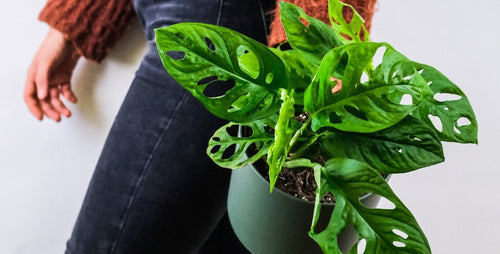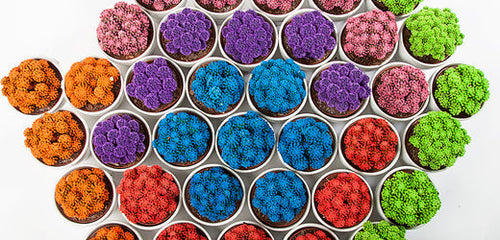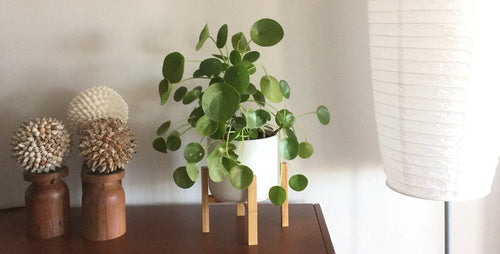By Karen Weir-Jimerson

How Colorful Plants Elevate Their Green Cousins
Colorful leafy plants are beautiful in their own right, but they also have a hidden talent: they make your green plants look even cooler.
Green houseplants get a colorful lift when displayed alongside colorful beauties such as purple passion plant and purple waffle plant.
It’s a design trick of contrast called using a foil. A foil is a colorful plant that contrasts (and thereby highlights) the qualities of less colorful plants.

Nerve Plant
Botanical name: Fittonia
The brightly etched leaves of fittonia make a beautiful and remarkable focal point. Fittonias offer plant collectors a sweet pastel palette of pink and white, deeper red and green, and green and white leaves. Varieties range from the pretty-in-pink ‘Frankie’ to the deeply red-veined ‘Ruby Red.’
Fittonia is also a popular plant for terrariums because of its colorful foliage. This small, leafy plant is commonly called nerve plant or mosaic plant because of the erratic patterned coloration in the leaves. Alone or in a group, fittonia is a pleaser. A great kitchen or office plant, fittonia prefers low to medium light.
Growing tip: This houseplant likes somewhat moist (but not wet, soggy) soil. It also like high humidity. See how to raise humidity levels around plants using a humidity tray.

Earth Star
Botanical name: Cryptanthus
These easy-care plants are ideal for the brightly lit spots in your home. (Think kitchen counters, living room tables, your WFH desk). Their leaves are not only colorful (a stripy mix of pink, white, green, and red, depending on the variety), but they are crinkled at the edges, which offers a nice bit of texture. The leaves are stiff and sturdy, and can actually be sharp edged, so keep them out of grabbing distance of small children.
Earth star leaves grow longer as they mature, but the plants hold their low-to-the-ground growth habit nicely. As their common name suggests, they look like little stars rising up from the earth.
Growing tip: Earth stars are beautiful when growing in low dishes or terrariums. If you are looking for planting pairings, try other bright-light lovers, such as cacti and succulents.

Polka Dot Plant
Botanical name: Hypoestes
If you need a little cheer for your day, add a polka dot plant to your home décor. This mounding little charmer offers red, pink, and white leaves splashed with dark green. Polka dot plants love bright or medium light, and can even tolerate a little direct sun on their foliage. You may have seen this plucky beauty used in patio and porch plantings as an annual, tucked into containers or window boxes because of its colorful demeanor. (If you use them outdoors in summer, you can remove them before cool weather sets in and pot them up to enjoy them indoors all winter -- then use them outdoors again the following spring.)
To help maintain polka dot plant’s compact, mounded shape, trim back stems as it grows; this plant can take a little trim off the top anytime it is needed. If you are dotty over polka dots, check out another spotty beauty: Polka Dot begonia.
Growing tip: Polka dot plant will tell you if you’ve let it get too dry. The leaves will wilt if it is too thirsty, but it’s quick to spring back to life when you water it again.

Purple Waffle Plant
Botanical name: Hemigraphis
Plant collectors say that the appeal of purple waffle plant is the leaves! There’s a lot going on. The leaves are two toned: the top is a glossy, light-catching green and the bottom is a rich matte purple. You can see both colors at the same time thanks to the compact growth habit of the plant which allows the crowded leaves to twist slightly to reveal the purple underside. Oh, and then there’s the texture. The leaves are slightly puckered.
Here’s the best thing: this colorful little plant is sublimely easy to care for. Just position it in medium to bright light and it will grow happily. Purple waffle plant is a beautiful understory or groundcover plant in a larger container. Pair it up with a tall species, such as fiddle leaf fern or corn plant.
Growing tip: Your purple waffle plant will reveal it is getting too little or too much light. If it isn’t getting enough light, the rich purple coloring on the leaf underside may fade. If it gets too much direct sun, the leaves may bleach and show signs of sunburn.

Dragon's Tongue
Botanical name: Hemigraphis repanda
Here’s another species of Hemigraphis that offers tousled grass-like leaves with wavy leaf edges in dark purple. This low, spreading plant is the perfect choice for dish gardens and terrariums. You can also use it as underplanting in a large container. (We love that look!)
Dragon’s tongue does well in a variety of light conditions: low, medium, or bright light. If it’s getting too little light, the leaves will be more green than purple. Move it into a brighter location to bring out the purple hues. You may also see a sprinkle of tiny white flowers.
Growing tip: Water dragon's tongue when the top inch or so of the potting mix is dry to the touch. It's not particularly drought tolerant, so don't let it wilt or dry out.

Purple Passion Plant
Botanical name: Gynuara
This unusual plant is loved by plant collectors because of the distinctive purple sheen of its leaves. Yep, plant lovers are passionate about purple passion plant and it is one of the top sellers. Take a closer look at the leaves and you’ll see they are actually green, but are covered in fine purple hairs. (This plant is also sometimes called velvet plant for this reason.)
This small colorful plant grows upright while young, but becomes vine-like as it matures. You can display it in a hanging basket. Or, if you want to encourage it to grow upward, simply insert a trellis or peat post to offer stems a leg up. If you prefer a more compact, shrubby look, pinch off new growth, which will encourage the plant to develop more branches.
Growing tip: Purple passion plant grows best in medium or bright light. Keep soil moist, but not wet.

Nanouk' Tradescantia
Botanical name: Tradescantia ‘Nanouk’
Tradescantia, also called inch plant, is a classic houseplant that can be used indoors in hanging baskets and outdoors as the trailing feature in patio containers and window boxes. There are several varieties of inch plant, offering different leaf colors. ‘Burgundy’ tradescantia features burgundy-purple leaves variegated with silver stripes along the edges. ‘Purple Heart’ (Tradescantia pallida) sports purple foliage and small pink flowers and is as popular for outdoor use (as an annual) as it is for houseplant fans.
But the new kid on the block is ‘Nanouk’, a Trending Tropicals® collection member that offers large green leaves striped with creamy pink and white. The big surprise is the underside of the foliage, which is hot pink. ‘Nanouk’ is so special, it’s even patented.
Growing tip: ‘Nanouk’ is ideal for desks and tabletops in the brightly lit areas of your home.. Thanks to its easy care and bright color, it's a perfect inspirational muse for your work desk. Or, consider hanging Nanouk in a place where you can admire it from below to enjoy the colorful leaf backsides.

Croton
Botanical name: Codiaeum
Crotons are one of the most colorful small plants for your home. Their boldly marked leaves sport so many colors--a color for every room. There are varieties with yellow, orange, red, and even black splashes. 'Andrew' has long, narrow leaves streaked in creamy white. 'Bush on Fire' also features long leaves that are splashed and stippled in shades of red, orange, gold, and purple. ‘Eleanor Roosevelt’ boasts narrow, mid-green leaves flushed with purple and speckled in golden yellow. ‘Mamey’ is loved for its twisty and curling dark leaves. If you want a tropical vibe, choose any variety of croton for your indoor décor.
Growing tip: If your croton doesn't get enough light, it may grow tall, spindly, and lose its colorful vibrancy. Place your croton in light that casts a strong shadow much of the day. You can also grow crotons in artificial light.

















